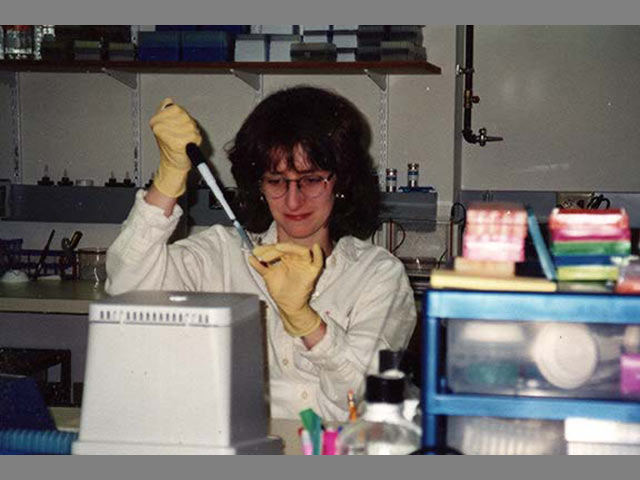Fighting Disease with Genetic Tests



How can breeders gain access to the instructions and eliminate diseases from their dogs? Genetic tests are the answer. Developing genetic tests is a long journey, involving people inside and outside the veterinary research laboratory.
Seeing the Invisible
Throughout most of the history of canine breeding, people have chosen which dogs to pair up, based on what is visible to the naked eye or how a dog behaves. These outward appearances are known as a dog's phenotype. Selecting by phenotype has allowed humans, over long periods of time, to create the characteristics we now see in purebred dogs. But it has also permitted many undesirable traits and diseases to persist. An Irish Setter may produce blind puppies, even though he has normal vision. Hoping to prevent blindness in the next generation, the breeder decides not to breed that dog any longer. But in the next generation, two more puppies are blind, even though the mother and father showed no signs of blindness. Generation after generation, the frustrated breeder experiences the same problem. The breeder could not know that the parents were each "carriers" of blindness: they had the genes, the potential to pass on the disease, but it was hidden. Using just the phenotype, breeders are destined to see the same problems arise, for centuries, in their dogs. This is not ancient history. Even today, most breeders make decisions based on phenotype.
Modern veterinary research has gained access to what is beyond phenotype. It has revealed the genotype, the genetic level, those things that are invisible to the naked eye, the causes of disease. For the first time in our long history with dogs, it is possible to know which dogs have the potential to spawn a disease. Breeders do not have to wait until an affected litter is born to determine which dogs have the problem.
Spotting the Guilty Genes
Whenever a dog has an inherited disease, a gene is mutated, or damaged. With knowledge of what all the canine genes are supposed to look like, researchers can see which ones are mutated. But being able to correlate that mutated gene to a specific disease is a painstaking process. To begin with, researchers focus their view at the microscopic, genetic level. Every cell in a dog (or any other animal) has a nucleus, and each nucleus contains 38 pairs of chromosomes. The 76 individual chromosomes are each packed with thousands of DNA molecules. By a silent force of nature, DNA molecules come together to form strings, each one a different length, anywhere from a few hundred to several million. These strings are genes, and every cell in an individual dog's body contains the same collection. The genes send out instructions to the cells on how to build organs and physiological systems. If even a single DNA molecule is missing, damaged, or in the wrong order, the gene is mutated, issuing bad instructions, and can be the cause of disease. To correlate a disease with a mutation, it must be proven that the same mutation occurs in all dogs with the same disease, and that the mutation does not appear in disease-free dogs.
In the beginning of their investigation, researchers potentially have to test every gene, which can number in the hundreds of thousands. Fortunately, based on general knowledge of genetics, the mutated gene can be isolated to one or two chromosomes. This is helpful, but a long way from an answer: there are still tens of thousands of possible genes. This stage can be extremely slow, as researchers examine numerous dogs looking for a pattern. Dr. George M. Strain, from Louisiana State University, collected information on 11,300 dogs for a study he conducted on hereditary deafness. "All too often," he reports, "things go for years with no apparent progress. You want quick answers, but it doesn't work out that way."
Over many hundreds of hours, researchers reduce the number of candidates. Finally, they spot a culprit gene, or what is known as a "marker." At this point, researchers have about an 85% probability that they are correct. Progress, but not victory.
Moving Beyond the Laboratory, Targeting the Guilty Gene
The next step is to screen numerous dogs, running skin or blood samples, determining if every affected dog has the mutation, and if unaffected dogs do not. University research facilities are not well suited for this task. Dr. Gregory Acland, a veterinary researcher at Cornell University, says, "The sheer amount of work involved in screening would cause an enormous strain and overwhelm any research laboratory." Researchers are interested in discovery. Once they have pointed the way to the cause, their talents are best applied to new searches. As Dr. Acland puts it, "I like to get to the problems we don't yet have solutions for."
The work of doing marker screens is taken up by a genetics testing organization. The largest of these is Optigen, located in Ithaca, New York, closely associated with Cornell University. Optigen communicates with breeders and breed clubs to attract dogs for testing, maintains a database of screened dogs, and shares whatever they learn with Cornell researchers. Dr. Jeanette Felix, president of Optigen, says, "We do what universities do not want to do. Universities would not allow it. They would tell their faculty, 'This is not research.'" Researchers can move on to new studies, Dr. Felix explains, but still have access to the knowledge gained from screening.
No cures for canine diseases can be found without the participation of breeders and breed clubs. During screening, Optigen may test thousands of dogs—the more the better—and they need to know each dog's lineage. Breeders and breed clubs are the only ones who can provide this level of information. As Dr. Felix explains, "Breeders know how frequent the condition is. They know which kennels we should go to in order to have the right dogs to screen. And breed clubs are instrumental in getting the pedigrees of individual dogs."
Addi Pittman is a breeder of English Cocker Spaniels, a dog that long suffered from Progressive Rod-Cone Degeneration (PRCD), a disease that leads to blindness. Ms. Pittman is one of the most active partners to research in the country, providing her own dogs for screening, linking other breeders with researchers, and filling boxes with color-coded folders of pedigrees. "It is so important for people to get involved early on," Ms. Pittman says, "to educate people about the disease and get them to do all the very important tests."
Eventually, the marker screens make it 100% certain which gene is responsible for a disease. With the cause determined, a standardized test is developed. Breeders can submit their dogs' tissue or blood samples, and a short analysis reveals an answer. This is called a genetic test. Addi Pittman, whose work led to a genetic test for PRCD, says, "Because of the work we did, we have seen a dramatic decrease of blindness in our breed."
Using this New Power Wisely
After testing all their dogs, breeders can create a genetics chart—a powerful tool that tells them which dogs have genes for an illness and which dogs are unaffected. At first, it may seem tempting to just stop breeding all dogs with any genetic signs of disease. However, as Dr. Felix explains it, "A breeder may want to eliminate the disease mutation in one generation. But that is very risky."
Dogs that are carriers for a disease almost always have desirable traits as well. That Irish Setter that produced blind puppies may have a beautiful coat, a great disposition, and just the right size. It would be unwise, and heartbreaking, for a breeder to sacrifice those positive traits, even if it meant eliminating blindness. Referring to the genetics chart, a breeder can breed that Irish Setter, keep the dog's positive traits, and also eliminate blindness. According to Dr. Felix, "For a recessive disease with carrier dogs, you can immediately avoid producing affected dogs by breeding always with one 'normal' in the pair. So, if your most beautiful dog is affected, you can still breed that dog."
Genetic tests are still relatively new. In real-world situations, breeders who use genetic tests arrange to mate their dogs from kennels that have not done testing. A breeder may be aware that it is safe to breed his wonderful dog, which he knows is a carrier for von Willebrand's disease,
as long as the other dog is unaffected. But he does not know the other dog's genetics. Even though the breeder realizes it is unwise, he may feel pressured to do exactly what Dr. Felix cautions against. He may stop breeding a quality dog that tests positive for a disease, and only choose his dogs that are unaffected and therefore safe to breed with any dog. To avoid this, more kennels will need to begin using genetic tests.
If genetic tests are applied intelligently, and widely, breeders have the power to free dogs of many inherited illnesses. Speaking of Optigen's test for PRCD, Dr. Felix says, "For breeds that these tests have been produced for, there is simply no reason to have any more blind dogs."
The Future of Genetic Tests
The past decade has been productive, with numerous genetic tests made available for several breeds. According to Dr. Felix, in the coming decade, "We will move more rapidly than we did in the past. There should be many more inherited diseases identified with their causes, and many more genetic tests developed." But developing the tests takes tremendous time and effort. For the work to continue, researchers and genetics testing organizations will need to study an expanding number of dogs. Breeders and breed clubs will have to become more involved in research.
The number of breeders who take part in research is still very small, because of doubts about how research is conducted, or fear that their kennels will be seen as producing "problem dogs." But modern researchers are vigilant about maintaining breeders' privacy, and the latest research techniques are non-invasive. Breeders supply paperwork. The dog usually just provides tissue or blood samples, often never leaving home, or at most staying briefly at a research facility. The owner is in full control at all times.
It is expected that we will soon have genetic tests for some types of cancer, various forms of blindness, deafness, skin and coat problems, skeletal ailments, heart disease, epilepsy, hip dysplasia, and others. The value of genetic tests does not stop with preventing disease. New genetic tests will be developed for qualities such as height and length, ear size, sense of smell, as well as behavioral characteristics like running, retrieving, and pointing. With more acceptance and educated use, these tests will greatly improve the lives of dogs, and the people who love them.
